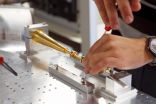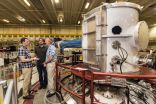(Press-News.org) This news release is available in Spanish.
The Journal of Optics has devoted the front page of its special edition on Mid-infrared and THz Photonics to the work produced by the NUP/UPNA-Public University of Navarre researchers Víctor Pacheco-Peña, Víctor Torres, Miguel Beruete and Miguel Navarro-Cía (former student currently working at Imperial College London), together with Nader Engheta (University of Pennsylvania), one of the world's leading experts in metamaterials. In their research they have proposed various devices capable of redirecting electromagnetic waves with efficiency levels close to 100%.
To explain what their work consists of they have put forward the following example: "If we shine a torch on a wall in which we have made a hole, experience tells us that the bigger the hole is, the greater the amount of light that will pass through to the other side. However, if we fill the hole with an ENZ metamaterial, something that appears to defy logic happens: the smaller the hole is, the greater the amount of light that passes through. This phenomenon has a tremendous practical implication because it opens up new ways of miniaturising numerous components and for light control."
Metamaterials are artificial materials with properties that go beyond those of natural means. To understand how they work, we can take a look at nature itself: while natural elements acquire their physical properties from the atoms that form them and the way in which they are ordered, metamaterials use natural means, like small metal fragments that fit together like parts of a Meccano model to artificially synthesise properties that are impossible to find otherwise. Initially put forward to control electromagnetic radiation, right now their use has become widespread and has extended to other areas like mechanical waves (sound, for example).
The piece of work referred to above proposes various compact devices comprising rectangular metal tubes with extremely narrow openings of dimensions designed in such a way that they are capable of redirecting the electromagnetic waves with levels of efficiency close to 100%. These gaps are capable of imitating an ENZ (Epsilon Near Zero, which means permittivity close to zero) metamaterial so that it is not necessary to "fill them" with anything in order to obtain amazing results.
Amazing Properties
Among the electromagnetic metamaterials, the above-mentioned ENZ ones make it possible to achieve the super coupling of the light, the tunnel effect and the confining of energy in tiny spaces. "Going back to the first example," say the authors, "super coupling means that all the light will be transferred from one side of the wall to the other through any shape of hole we want to make; tunnel effect refers to light passing through a hole of any length, no matter how long we want to make it; and the confining of energy is due to the fact that the light is transferred even through very small holes, so the energy inside the hole is squeezed enormously."
This work has shown theoretically and by means of simulations how beam steerers and power splitters work for terahertz waves, and is of tremendous importance in view of their huge potential in sectors like security, biomedical engineering, pharmacy, space, etc. Right now, the authors of this piece of research are working to confirm the study through experimental means. In this respect, they stress that "this constitutes another milestone in an initiative of an international nature that has been going on for nearly four years".
INFORMATION:
A piece of work demonstrates various ways for controlling light in the terahertz frequency
2014-09-23
ELSE PRESS RELEASES FROM THIS DATE:
New hope for beloved family pets
2014-09-23
Nearly one out of four dogs will develop cancer in their lifetime and 20 per cent of those will be lymphoma cases.
A team of researchers from the University of Leicester has helped Avacta Animal Health Ltd to develop a new user-friendly electronic system for diagnosing lymphoma in dogs in the early stages, and for remission monitoring.
Marketed as cLBT (canine lymphoma blood test), this is the first test of its kind to track the remission monitoring status of a dog after undergoing chemotherapy.
Led by Professor Alexander Gorban from the University's Department ...
Kinsey study of single parents' dating, sexual activity contradicts assumptions
2014-09-23
BLOOMINGTON, Ind. -- Contrary to what is often assumed about single parents, particularly single parents of young children, a new study from The Kinsey Institute has found that single parents of children younger than 5 date and are sexually active as often as singles without children -- and more so than single parents of older children.
The study, "Dating and Sexual Behavior Among Single Parents of Young Children in the United States," was published online in the Journal of Sex Research prior to appearing in print. Co-authors are lead author Peter B. Gray, University ...
Smart meters could cause conflict for housemates, study shows
2014-09-23
Arguments about whose turn it is to do the washing up, negotiating rights to the TV remote control and disputes over noise — as many students returning to university for the new academic year are about to learn the hard way, sharing a house can be a tricky business.
And now research from academics at The University of Nottingham has revealed that new technology to allow people to monitor their energy usage in the home could be about to ratchet up the tension.
The study by a team of technology experts and psychologists found that meters which allowed residents to look ...
EORTC presentations at ESMO 2014 Congress
2014-09-23
EORTC investigators will present the results of their cancer research at ESMO 2014 Congress, 26-30 September 2014 in Madrid.
Joint Symposium: ESMO-ASCO: The Evolution of the clinical trial landscape
Monday, September 29, 11:00 AM - 12:30 PM, Room: Granada
Abstract 121IN: Denis Lacombe. Can Collaborative Molecular Screening Platforms support new forms of cancer clinical research? The example of the EORTC SPECTA program.
Proffered Paper session: Melanoma and other skin tumors
Saturday, September 27, 2:00 PM - 3:45 PM, Room: Barcelona
Eggermont AM, Chiarion-Sileni ...
Opportunities to reduce patient burden associated with breast cancer screening
2014-09-23
New Rochelle, NY, September 23, 2014—New technology and better screening strategies can lower the rate of false-positive results, which impose a substantial financial and psychological burden on women. The many misperceptions about breast cancer screening options and risks, the benefits and costs of screening, and the need for new approaches and better education are discussed in a series of articles in a supplement to Journal of Women's Health, a peer-reviewed publication from Mary Ann Liebert, Inc., publishers. The supplement is available free on the Journal of Women's ...
2014 Arctic sea ice minimum sixth lowest on record
2014-09-23
Arctic sea ice coverage continued its below-average trend this year as the ice declined to its annual minimum on Sept. 17, according to the NASA-supported National Snow and Ice Data Center (NSIDC) at the University of Colorado, Boulder.
Over the 2014 summer, Arctic sea ice melted back from its maximum extent reached in March to a coverage area of 1.94 million square miles (5.02 million square kilometers), according to analysis from NASA and NSIDC scientists. This year's minimum extent is similar to last year's and below the 1981-2010 average of 2.40 million square miles ...
Actions on climate change bring better health, study says
2014-09-23
MADISON, Wis. — The number of extremely hot days in Eastern and Midwestern U.S. cities is projected to triple by mid-century, according to a new study led by University of Wisconsin-Madison researchers and published today in the Journal of the American Medical Association.
Milwaukee and New York City could experience three times as many 90-degree days by 2046; Dallas could see twice as many days topping 100 degrees. The new analysis offers climate data through the lens of public health, in a study that represents a synthesis of the latest science at the intersection of ...
Sandia magnetized fusion technique produces significant results
2014-09-23
ALBUQUERQUE, N.M. — Researchers at Sandia National Laboratories' Z machine have produced a significant output of fusion neutrons, using a method fully functioning for only little more than a year.
The experimental work is described in a paper to be published in the Sept. 24 Physical Review Letters online. A theoretical PRL paper to be published on the same date helps explain why the experimental method worked. The combined work demonstrates the viability of the novel approach.
"We are committed to shaking this [fusion] tree until either we get some good apples or a ...
Critically ill ICU patients lose almost all of their gut microbes and the ones left aren't good
2014-09-23
Researchers at the University of Chicago have shown that after a long stay in the Intensive Care Unit (ICU) only a handful of pathogenic microbe species remain behind in patients' intestines. The team tested these remaining pathogens and discovered that some can become deadly when provoked by conditions that mimic the body's stress response to illness.
The findings, published in mBio®, the online open-access journal of the American Society for Microbiology, may lead to better monitoring and treatment of ICU patients who can develop a life-threatening systemic infection ...
Video blinds us to the evidence, NYU, Yale study finds
2014-09-23
Where people look when watching video evidence varies wildly and has profound consequences for bias in legal punishment decisions, a team of researchers at New York University and Yale Law School has found. This study raises questions about why people fail to be objective when confronted with video evidence.
In a series of three experiments, participants who viewed videotaped altercations formed biased punishment decisions about a defendant the more they looked at him. Participants punished a defendant more severely if they did not identify with his social group and punished ...





